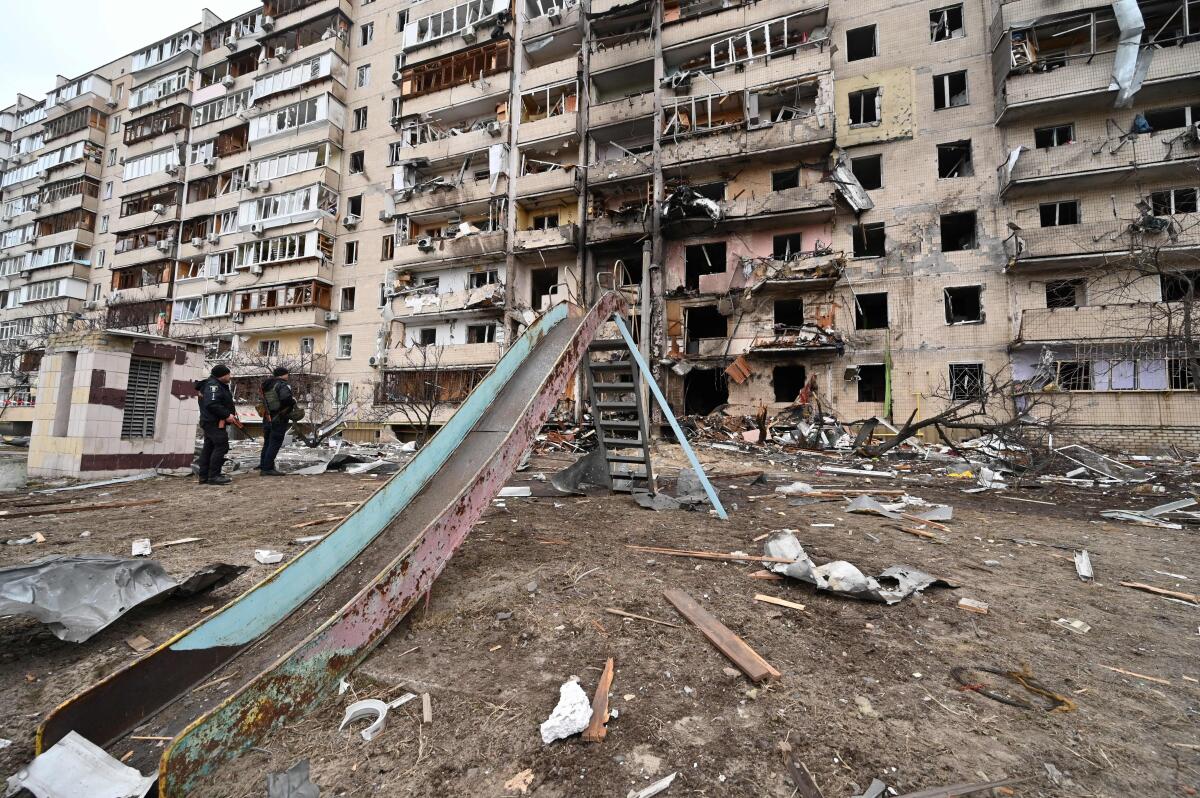Op-Ed: The West should stop financing Putin’s war

- Share via
On Thursday, the first day of the full-scale invasion of Ukraine, the West paid Russia about $500 million. That’s the average daily value of purchases of Russian energy by the European Union, the United Kingdom and the United States. As the conflict continues, the daily flow of cash has remained about the same. Europe, in particular, is effectively financing Russian aggression, the destruction of lives and livelihoods, and the creation of a massive refugee crisis. Why?
The short answer is that the West has been slow to recognize the full danger of Russian President Vladimir Putin’s intentions. For millions of Ukrainians, the continuing flow of money is fueling tragedy.
The strength — and weakness — of Russia’s economic position is evident from its foreign-trade statistics, which were analyzed in a working paper published this month by the Bank of Finland Institute for Emerging Economies. Most of Russia’s exports are oil, petroleum products and gas ($240 billion in 2019), and more than half of them go to the EU. The rest of Russia’s exports combined ($48.5 billion) amount to less than the value of its gas exports ($51 billion).
China buys 28% of Russia’s oil, but only 5% of its petroleum products and about 1% of its gas. The EU buys almost 64% of Russian gas and the U.K. buys an additional 4.5%.
To be sure, disconnecting selected Russian banks from the SWIFT messaging system used by financial institutions to facilitate transactions worldwide will make it more cumbersome for Russian companies to be paid for European energy deliveries. But payment through telex, telephone, other networks or third parties provides fallback options.
The obvious solution is to stop paying for Russian gas altogether — or to pay into an escrow account until Russia withdraws its forces from Ukraine. The Russian reaction presumably would be to shut off deliveries, but Europe claims to have enough stocks to get through this winter, so this is partly about the costs of preparing for next winter.
Those costs are likely to be high, because any disruption to world energy supplies typically drives up the price of oil or gas, or both, which would presumably affect the EU, the U.S. and the global economy more broadly. It would also complicate the central banks’ task of controlling inflation. But policymakers have dealt with bigger issues, including the COVID-19 crisis in 2020-21 and the global financial crisis in 2008.
Germany’s energy strategy has relied on Russian gas since the 1960s. But although deliveries proved reliable throughout the remainder of the Cold War and the aftermath of the Soviet Union’s collapse, it is no longer a sustainable arrangement. Putin’s rationale for launching all-out war against Ukraine — to reimpose Soviet-era borders — has existential implications for the EU’s ex-Soviet members: Estonia, Latvia and Lithuania. Business as usual is, or should be, out of the question.
The effect of denying Russia its daily inflow of foreign cash depends on whether it could use its accumulated foreign-exchange reserves to buy needed imports, which cost $380 billion (25% of gross domestic product) in 2021. To pay for imports from a Western country, euros, dollars or another Western currency is needed. Italian or French exporters are unlikely to accept payment in gold, Chinese renminbi or cryptocurrency.
The Central Bank of Russia has been preparing: Reserves reached a record high of $638.2 billion on Jan. 14. And, unlike most central banks, since 2018 the CBR has held relatively little of its reserves in U.S. Treasury securities at the Federal Reserve Bank of New York.
But does that mean Russia could outlast an EU-led embargo on its energy products? U.S. sanctions obviously can prohibit any U.S. bank or other entity from dealing with Russian companies or the official sector, and some first steps were announced Thursday. Less understood is that properly designed “secondary sanctions” can also prohibit U.S. banks from clearing transactions that are arranged by third parties on behalf of Russia. To be effective, steps in this direction would need to be matched by the eurozone authorities, as well as by the U.K.
As part of new sanctions, the EU announced Sunday that more than half of the reserves of the Central Bank of Russia will be blocked. The U.S. Treasury Department said on Monday that it also would prohibit transactions with the Central Bank of Russia. Enforcement will be a challenge, because no one knows exactly where the CBR is holding its reserves. Credible reports suggest they are hidden in opaque offshore markets, perhaps through transactions with EU or Swiss banks. According to Zoltan Pozsar of Credit Suisse, half of all Russian reserves may be held in dollars, concealed using foreign-exchange swaps. These spot sales and forward purchases of U.S. dollars mean that the CBR is effectively lending dollars against collateral denominated in other currencies. If true, this is further confirmation that the CBR needs access to dollars for its transactions.
Pozsar is concerned that sanctions could rattle funding markets. This issue requires immediate attention from the U.S. Federal Reserve, working with the Financial Stability Board and other relevant authorities. Again, policymakers have dealt with bigger shocks in recent decades.
In addition, Russia should be suspended immediately from the International Monetary Fund. That would send a clear signal to financial and currency markets that Russia will not be able to draw on its reserves held in the form of Special Drawing Rights.
To be sure, these measures would amount to a radical departure from postwar norms. But Putin tore up those norms on Thursday.
Simon Johnson, a former chief economist at the International Monetary Fund, is a professor at MIT’s Sloan School of Management. He is a coauthor of “Jump-Starting America: How Breakthrough Science Can Revive Economic Growth and the American Dream.”
More to Read
A cure for the common opinion
Get thought-provoking perspectives with our weekly newsletter.
You may occasionally receive promotional content from the Los Angeles Times.










